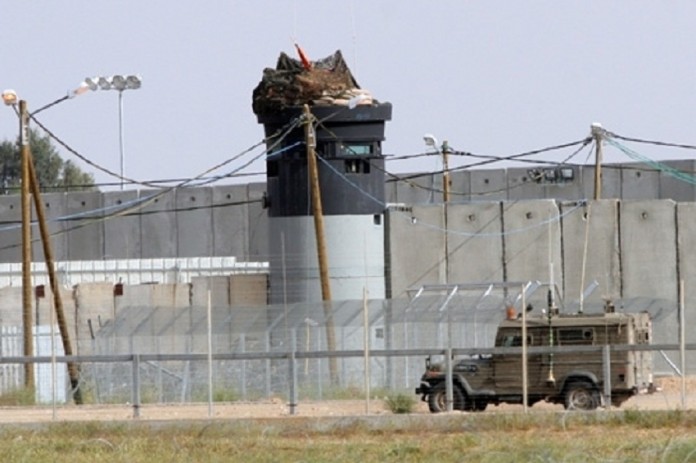
PCHR Fact Sheet July 2019
The term “buffer zone” in land and at sea is used for land and sea areas unilaterally and illegally declared by Israel as no-access areas along the eastern and northern borders, as well as the Gaza Strip sea following the Israeli Disengagement Plan in 2005. In violation of the provisions of the international humanitarian law, the Gaza Strip’s population are denied access to their property in the so-called “buffer zone” in land while the fishermen are prevented from sailing and fishing in the “buffer zone” at sea. The buffer zone area varies from time to time according to the Israeli forces’ declarations, without consideration for international law ban on any changes to occupied territories. According to Israeli forces instructions, the “buffer zone” extends to an area ranging between 100 to 1,500 meters in some eastern land borders, while at sea, it ranges between 3 to 9 nautical miles.
Israeli forces expanded the fishing area in the Gaza Strip from 3 nautical miles to 6 following the ceasefire agreement post November 2012 Israeli offensive. However, there is conflict over the Access Restricted Area (ARA) in land, thereby, Palestinian civilians are exposed to grave dangers within its unclarified parameters. In a statement on his official website, the Israeli Coordinator of Government Activities in the Territories (COGAT) declared that fishermen could now access the sea up to 6 nautical miles offshore, and that farmers could now access lands in the border area up to 100 meters from the border fence. However, both references have since been removed from the statement, which obviously indicates the Israeli forces retreat of the abovementioned ceasefire. On 21 March 2013, the Israeli forces’ spokesperson announced re-reducing the fishing area allowed for Palestinian fishermen from 6 nautical miles to 3 nautical miles. The same announcement also included the re-expansion of the in-land “buffer zone” an extra 300 meters. However, on 21 May 2013, the Israeli authorities decided to allow fishermen to sail up to 6 nautical miles.
Following the 2014 Israeli offensive on the Gaza Strip, the ceasefire agreement allowed fishermen to sail up to 6 nautical miles. However, fishermen were unable to reach said distance due to continued Israeli attacks and harassment. On 07 March 2015, Israeli naval forces declared via loud speakers that the allowed fishing area was reduced to 4 nautical miles and warned Palestinian fishermen from approaching this area along the Gaza Sea. On 01 April 2016, Israeli authorities expanded the fishing area from 6 to 9 nautical miles between the areas of the Gaza valley to the southern Gaza Strip; meanwhile, they denied access beyond 6 miles in the other areas. On 03 May 2017, the Israeli authorities allowed fishermen to fish up to 9 nautical miles, instead of 6 nautical miles in the Strips’ southern and northern sea.
In early April 2019, Israeli forces announced the expansion of the fishing area within the Gaza Sea between 6 -15 natuical miles. However, this expansion did not grant a positive impact on fishermen’s work, especially in terms of increased production. The expansion of the fishing area was as follows:
On 30 April 2019, Israeli forces informed Palestinians that the fishing area was reduced again to 6 nautical miles across the Gaza Sea. Also, Israel imposed a 5-day complete ban on fishing and access to the sea from 13 – 18 June 2019. Afterwards, fishing was allowed at 6 nautical miles from the norther Gaza Strip up to the Gaza City sea; and at 10 nautical miles from Gaza Valley up to Rafah. On 28 June 2019, Israeli forces re-expanded the fishing area to 15 nautical miles in the central Gaza Strip and 9 nautical miles in its north and south.
According to field updates followed up by PCHR, the Israeli forces have escalated their attacks against the Palestinian civilians, including farmers and fishermen, and prevented them from safe and free access to their lands and fishing areas. This constitutes a violation of their rights according to the international human rights standards, including their right to security, personal safety and protection of their property, their right to work, the right to adequate standard of living, and the right to the highest attainable standard of health. Enforcing the “buffer zone” through the use of live fire which has often led to direct targeting of civilians, is a war crime, where killings under these circumstances constitute a wilful killing in grave violation of the Geneva Conventions of 1949.
July 2019 Attacks
| Attacks | Total | “Buffer zone” on land | “Buffer zone” at sea |
| Shelling | 0 | 0 | 0 |
| Shooting | 394 | 374 | 20 |
| Incursions | 4 | 4 | 0 |
| Land levelling | 0 | 0 | 0 |
| Detention incidents | 5 | 3 | 2 |
| Total incidents | 403 | 381 | 22 |
Consequences of attacks
| Consequences | Total | “Buffer zone” on land | “Buffer zone” at sea |
| Death of persons | 1 | 1 | 0 |
| Minors | 0 | 0 | 0 |
| Women | 0 | 0 | 0 |
| Injury of persons | 341 | 340 | 1 |
| Minors | 145 | 145 | 0 |
| Women | 16 | 16 | 0 |
| Consequences | Total | “Buffer zone” on land | “Buffer zone” at sea |
| Property damaged | 0 | 0 | 0 |
| Property confiscated | 2 | 0 | 2 |
| Dunums razed | 0 | 0 | 0 |
| Consequences | Total | “Buffer zone” on land | “Buffer zone” at sea |
| Total persons detained | 8 | 4
|
4 |
| Minors detained | 1 | 0 | 1 |
| Women detained | 0 | 0 | 0 |